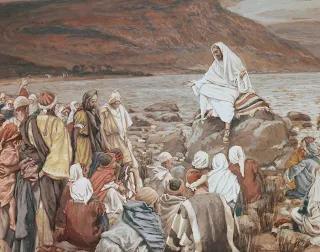In the Gospel of Matthew (13:3-9, 18-23), Jesus tells the Parable of the Sower, a brief but profound story that illustrates the path of the divine message to human hearts. With apparent simplicity, this parable reveals the different ways in which the message of the Kingdom of God is received, and how human beings, with their diverse responses and attitudes, determine the fruit they produce in their lives.
The Story
Jesus describes a sower who went out to sow his seed. As the seeds fell on different types of soil, they experienced different fates:
Seeds fallen along the path : These seeds were devoured by birds, representing those who hear the message but do not understand it; the lack of understanding allows the evil one to "steal" what was sown.
Seeds fallen on rocky ground : Here, the seeds sprouted quickly, but because they did not have deep roots, they dried up when they received the heat of the sun. This ground symbolizes those who receive the message with joy, but because they do not deepen their faith, they quickly fade away when trials and difficulties arrive.
Seeds fallen among thorns : These seeds grew, but were choked by thorns, representing the worries of life and the deceitfulness of riches. They are those who begin to grow in faith, but are choked by the material desires and anxieties of the world.
Seeds fallen on good soil : These seeds, when they fell on fertile soil, bore fruit in abundance, producing crops of thirty, sixty, and even a hundred times what was sown. This soil represents those who hear, understand, and allow the message to take root deep in their hearts, transforming themselves and producing abundant fruit.
Spiritual Interpretation
Jesus gives a clear explanation of this parable to his disciples, emphasizing that the seed is the "Word of the Kingdom" (Matthew 13:19). The different soils represent the different ways in which people receive the Gospel message. The parable invites us to reflect on our attitudes toward Jesus' message and our spiritual state.
- The Path : Warns us about a lack of understanding. Often, indifference or superficiality prevents us from understanding the message in depth, leaving us vulnerable to having the "bad" steal it from our minds and hearts.
- The rocky ground : It is a call to go deeper. Superficial faith, without solid roots, breaks down in the face of adversity. This part of the parable invites us to go beyond a passing faith and build a firm and deep relationship with God.
- Among Thorns : Reminds us of the danger of worldly distractions. Worries, the excessive pursuit of material goods and the focus on riches take us away from the spiritual and suffocate our faith. Here, the teaching points to the importance of prioritizing the eternal over the fleeting.
- Good soil : This is the desired goal. Good soil represents a willing, humble, and receptive heart that allows God's message to transform one's life. Those who embody this attitude are the ones who truly produce fruit, reflecting the love, compassion, and justice of the Kingdom.
Practical Application
The Parable of the Sower not only invites us to examine the state of our hearts, but also challenges us to cultivate the "good soil" in our spiritual life. Here are some practical suggestions:
Seeking understanding : Deep understanding often comes from reflection and study. Spending time reading and studying Jesus’ teachings helps us understand the message on a personal level.
Developing Roots : Prayer, meditation, and participation in a community of faith are tools that deepen our relationship with God, allowing us to face trials with resilience.
Letting Go of Distractions : Examining our priorities and reducing the time and energy invested in material and transitory things helps us avoid drowning out God's message in our hearts.
Accepting transformation : Good soil does not emerge overnight; it is a process of change and inner renewal. Humility and openness to change allow the divine message to bear fruit in abundance.
Final Thoughts
The Parable of the Sower, like all of Jesus' teachings, is an invitation to look inside ourselves and recognize the ground we are offering to God's message. Are we like the path, the rocky ground, the thorns, or the good soil? The good news is that we have the opportunity to cultivate our hearts and prepare them to receive and bear fruit.
This process involves patience, self-knowledge, and a constant willingness to change. Good soil is not found by accident; it is the result of conscious and dedicated work in the spiritual life. And the fruit it produces is not only a blessing for ourselves, but a source of light and hope for those around us, spreading the message of the Kingdom of God through our lives.
References
- Matthew 13:3-9, 18-23

.jpeg)


